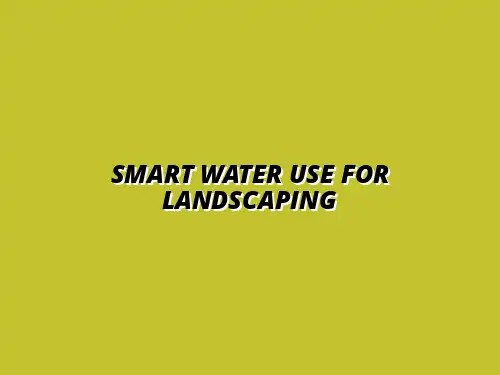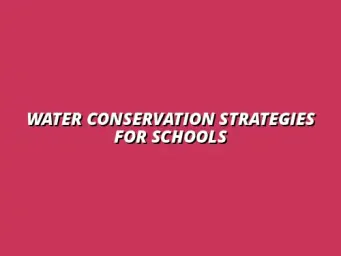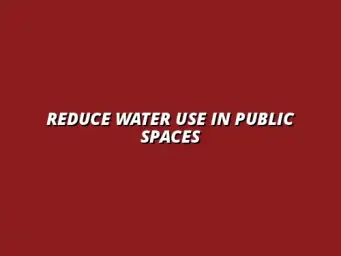Understanding Efficient Water Usage in Landscaping for Dry Climates
In dry climates, efficient water usage in landscaping is crucial. With limited rainfall and high evaporation rates, it becomes essential to make thoughtful choices about plant selection and garden design. This approach not only conserves water but also helps create sustainable and beautiful outdoor spaces.
By understanding the principles of water conservation, we can make better decisions that benefit both the environment and our gardens. Implementing strategies for efficient water usage leads to healthier landscapes and supports the local ecosystem. Let’s dive into why water conservation is particularly significant in arid regions. This is especially important when considering the impact of managing poor drainage in gardens, which can exacerbate water waste.
Significance of Water Conservation in Arid Regions
Water conservation plays a pivotal role in maintaining the health of landscapes in dry regions. As water becomes scarcer, it’s vital to rethink how we use this precious resource. Conserving water not only helps our gardens thrive but also promotes a sustainable future for our communities. Learn more about the benefits of water-efficient irrigation to further enhance your water conservation efforts.
Here are some key reasons why water conservation is essential in arid climates:
- Reducing Water Demand: Helps manage limited water resources effectively.
- Protecting Local Ecosystems: Supports native wildlife and plant species.
- Lowering Utility Costs: Minimizes water bills for homeowners and businesses.
Impact of Drought on Landscaping Choices
During periods of drought, our landscaping choices must adapt to the harsh conditions. Many traditional plants may not survive or thrive, leading to a shift towards more resilient options. By selecting drought-tolerant plants, we can create beautiful gardens that withstand dry spells and require less irrigation.
Furthermore, understanding the effects of drought encourages us to implement proactive measures. This includes considering the overall design of our landscapes and making them more sustainable and efficient. Choosing the right plants can significantly reduce the impact of drought on our gardens. Proper maintaining outdoor plumbing systems is also crucial for efficient water usage.
Benefits of Sustainable Landscaping Practices
Adopting sustainable landscaping practices comes with several benefits for both the environment and our living spaces. These practices not only help conserve water but also enhance the beauty of our gardens. Here are some notable advantages:
- Enhanced Biodiversity: Attracts various wildlife species to your garden.
- Soil Health Improvement: Promotes healthy soil through organic methods.
- Increased Property Value: Well-designed landscapes can boost home value.
Principles of Efficient Water Usage in Landscaping
Efficient water usage in landscaping revolves around several core principles. By focusing on these principles, we can create gardens that thrive with minimal water input. It begins with understanding the right plants to choose and how to manage the soil effectively. Remember that even small changes can make a big difference in water conservation; consider exploring green plumbing for water savings.
Let’s explore these principles to make our gardens more water-efficient and sustainable.
Water-Efficient Plant Selection for Dry Climates
Choosing the right plants is the foundation of any water-efficient landscape. Drought-resistant plants, often native to arid regions, require less water and are better adapted to survive in dry conditions. These plants not only conserve water but also add unique beauty to our gardens.
When selecting water-efficient plants, consider these options:
- Succulents: Store water in their leaves and require minimal irrigation.
- Herbs: Many herbs thrive in dry conditions, such as rosemary and sage.
- Native Grasses: Adapt well to local climates and attract pollinators.
Understanding Soil Types and Water Retention
The type of soil in your landscape plays a crucial role in water retention. Different soil types absorb and hold water differently, affecting how much irrigation is needed. Understanding your soil’s properties can lead to better gardening practices.
For effective water usage, consider these soil types:
- Sandy Soil: Drains quickly, requiring more frequent watering.
- Clay Soil: Retains moisture but can become compacted and hinder drainage.
- Silty Soil: Retains moisture well, offering a balanced approach.
Innovative Gardening Techniques for Water Conservation
As we seek to optimize water usage in our landscapes, innovative gardening techniques come to the forefront. These techniques not only conserve water but also enhance the overall health of the garden. Implementing these methods can make a significant difference in how we manage our water resources. For more tips on reducing water use, visit our page on reducing water use in gardens.
Let’s explore some effective gardening techniques that promote water conservation.
Implementing Xeriscaping for Minimal Water Use
Xeriscaping is a gardening approach designed specifically for dry climates. This method uses drought-tolerant plants and natural landscaping techniques to minimize water usage. By creating a xeriscape, we can build stunning gardens that thrive without excessive irrigation.
Key components of xeriscaping include:
- Grouping Plants: Place plants with similar water needs together.
- Using Rock Mulch: Reduces evaporation and adds visual appeal.
- Creating Contour Beds: Helps capture and retain rainwater.
Mulching and Its Benefits for Soil Moisture
Mulching is a simple yet effective technique for conserving soil moisture. Adding a layer of mulch around plants can significantly reduce evaporation, keeping the soil cooler and wetter. This practice not only benefits the plants but also suppresses weeds and improves soil health.
Here are some benefits of using mulch in your landscape:
- Moisture Retention: Helps maintain soil moisture levels.
- Weed Control: Reduces competition for water and nutrients.
- Temperature Regulation: Keeps soil temperatures consistent.
Smart Irrigation Practices to Optimize Water Usage
Implementing smart irrigation practices is essential in maximizing water efficiency in landscaping. Using the right irrigation systems and techniques can drastically reduce water waste. By focusing on these practices, we can ensure our gardens receive the water they need without over-irrigating. For a comprehensive guide to maintaining your home's plumbing and appliances, check out our water heater maintenance checklist.
Let’s take a closer look at effective irrigation strategies suitable for dry climates.
Types of Irrigation Systems Suitable for Dry Climates
Choosing the right irrigation system can make a world of difference in how efficiently we use water. Different systems offer various benefits, so it’s important to select one that matches your landscape’s needs. Here are some effective irrigation options:
- Drip Irrigation: Delivers water directly to the roots, minimizing waste.
- Soaker Hoses: Releases water slowly along the length of the hose.
- Smart Sprinklers: Adjust watering schedules based on weather conditions.
Scheduling Watering to Minimize Evaporation
Timing is everything when it comes to irrigation. Watering during the coolest parts of the day, such as early morning or late evening, can significantly reduce evaporation. By strategically scheduling watering, we can ensure that more water reaches the plants rather than being lost to the atmosphere.
Consider these tips for effective watering schedules:
- Water Early: Morning is the best time to minimize evaporation.
- Avoid Windy Days: Wind can carry water away from plants.
- Use Rain Sensors: Automatically adjust watering based on rainfall.
Integrating Rainwater Harvesting into Landscaping
Rainwater harvesting is an excellent way to supplement our water needs in landscaping. Collecting rainwater can provide an additional source of water for plants while reducing reliance on municipal sources. This practice not only helps conserve water but also makes our gardens more sustainable. If you are located in Billesley, Birmingham and need plumbing assistance, you can find a local plumber in Billesley, Birmingham.
Let’s explore how we can effectively integrate rainwater harvesting into our landscaping practices.
Designing a Rainwater Collection System
Creating a rainwater collection system is a practical step towards efficient water usage. Simple systems can be designed to capture runoff from gutters and direct it to storage containers. These systems can be tailored to fit various landscape styles and sizes.
Here are some essential components to consider:
- Gutters and Downspouts: Direct rainwater efficiently to storage tanks.
- Storage Tanks: Store collected rainwater for later use.
- Filtration Systems: Keep the water clean and safe for plants.
Utilizing Rain Gardens for Efficient Water Management
Rain gardens are another fantastic way to manage rainwater and enhance our landscapes. These specially designed gardens can capture and absorb excess rainwater, reducing runoff and promoting groundwater recharge. Rain gardens also serve as beautiful features in our yards!
To create a successful rain garden, consider these elements:
- Location: Choose a low-lying area that collects rainwater.
- Plant Selection: Use native plants that thrive in wet and dry conditions.
- Soil Preparation: Ensure the soil has good drainage for optimal water absorption.
Common Challenges and Solutions in Dry Climate Landscaping
Landscaping in dry climates presents unique challenges, but they can be managed with the right strategies. From soil erosion to pest management, being proactive is key to maintaining a healthy landscape. Let’s look at some common challenges and the solutions that can help us succeed.
Identifying and addressing these issues promptly can lead to thriving gardens even in tough conditions.
Addressing Soil Erosion and Compaction
Soil erosion and compaction are common problems in dry landscapes. Wind and rainfall can wash away valuable topsoil, while foot traffic can compact the soil, making it hard for plants to thrive. Mitigating these issues is crucial for maintaining healthy soil and plant life.
Here are effective strategies to combat soil erosion and compaction:
- Plant Ground Covers: Prevent soil erosion by stabilizing the ground.
- Build Terraces: Create level areas to slow down water runoff.
- Use Organic Matter: Incorporate compost to improve soil structure.
Managing Pest and Weed Control Naturally
Managing pests and weeds can be challenging in dry climates, but natural approaches can be effective. Utilizing companion planting and organic pest control methods can minimize the need for chemicals. This not only protects our plants but also promotes a healthier ecosystem.
Some natural solutions include:
- Companion Planting: Pair plants to deter pests naturally.
- Hand-Weeding: Remove weeds manually to avoid herbicides.
- Beneficial Insects: Attract ladybugs and lacewings for natural pest control.
Practical Guidelines for Implementing Efficient Water Usage
When it comes to conserving water in landscaping, having a solid plan makes all the difference! A sustainable landscape plan helps ensure that your garden not only thrives but also uses water efficiently. Let’s dive into some practical guidelines that make creating a water-efficient landscape a reality.
Starting with a comprehensive understanding of your landscape’s specific needs is crucial. This can help you identify areas where you can save water while still enjoying a beautiful garden. Below, I share some essential steps you can take to assess your landscape’s water needs effectively.
Creating a Sustainable Landscape Plan
To kick off your sustainable landscape plan, you need to take a close look at your current setup. By analyzing your landscape, you can pinpoint exactly how much water your plants require and what improvements are possible. Here are some steps to assess your landscape’s water needs:
- Evaluate your current plantings to see how much water they need.
- Check for areas of runoff or drainage issues.
- Observe how different sections of your garden respond to heat and moisture.
- Consider the size of your garden and how much of it is shaded or sunny.
Another important aspect of your plan involves choosing the right plants. Selecting native plants that are already adapted to your local climate can significantly reduce the amount of water required. Native plants are typically low-maintenance and resilient, making them ideal for sustainable landscaping. Remember that efficient water usage is key to a healthy garden and responsible environmental stewardship. Check out this article about reducing water use in gardens for further insights.
Steps to Assess Your Landscape’s Water Needs
It's essential to continually monitor your water usage and be aware of how different plants respond to their environment. Regular assessments allow you to make adjustments as necessary. Here’s how you can keep track:
- Conduct regular inspections of your plants to gauge their health.
- Measure soil moisture levels using a simple moisture meter.
- Track rainfall and assess how it impacts your watering schedule.
By following these steps, you can create a plan that keeps your garden thriving while conserving water. It’s all about making smart choices that benefit both your landscape and the environment!
Community Resources and Support for Sustainable Landscaping
One of the best ways to enhance your sustainable landscaping efforts is to tap into community resources. Finding support and learning from others can offer inspiration and practical advice! Here are some community resources that can help:
- Local gardening groups that focus on sustainable practices.
- Educational workshops that provide hands-on training.
- Online forums where you can ask questions and share experiences.
These resources not only provide valuable information but also connect you with like-minded individuals who share your passion for efficient water usage in landscaping.
Local Gardening Groups and Educational Workshops
Participating in local gardening groups can be incredibly beneficial. These groups often host workshops on various topics related to sustainable practices. Here are some topics you might encounter:
- Xeriscaping techniques for water conservation.
- Choosing drought-tolerant plants for your garden.
- Watering strategies and tools to optimize usage.
By engaging with these groups, you can learn new skills and gain insights that will help you succeed in your landscaping journey!
Frequently Asked Questions about Water Usage in Landscaping
As you begin your landscaping project, you might have some questions about water usage. Understanding the needs of your plants and watering strategies can help maximize your efficiency. Here are some common frequently asked questions:
How much water do drought-resistant plants need?
This is a great question! Generally, drought-resistant plants require less frequent watering compared to traditional varieties. On average, they may only need water once every two weeks, depending on the climate and soil conditions. It's always a good idea to check the moisture level in the soil before watering.
What are the best times to water my garden?
Timing is crucial when it comes to watering. The best times to water your garden are early in the morning or late in the evening. This helps minimize evaporation and allows your plants to absorb more water. Remember, consistent watering is key to keeping your garden healthy!
Encouraging Community Action for Water Conservation
It's not just about what you do in your garden. You can also encourage others in your community to adopt water-saving practices! Raising awareness about efficient water usage can lead to a more sustainable environment for everyone. Here are some ways to promote community action.
- Organize local workshops focused on sustainable landscaping.
- Create informational flyers or social media posts about water conservation.
- Partner with local schools to teach kids about gardening and sustainability.
By fostering a sense of community around water conservation, you can inspire others to make a difference!
Promoting Awareness on Efficient Water Practices
Every little bit helps when it comes to conserving water! Sharing your journey and tips can motivate others to join in. You can create awareness through:
- Community events that showcase successful landscaping projects.
- Social media campaigns highlighting water-saving techniques.
- Collaborations with local businesses and environmental organizations.
These efforts can lead to impactful changes in how the community approaches landscaping and water usage!
Summarizing Key Strategies for Efficient Water Management
As we wrap up this guide, it's important to remember some key strategies for efficient water management in landscaping. By utilizing the right plants, practices, and community resources, you can create a beautiful and sustainable landscape. Here are the best practices for landscaping in dry climates:
- Choose native, drought-resistant plants.
- Implement smart irrigation techniques.
- Utilize mulching and xeriscaping methods.
- Engage with community resources and initiatives.
With these strategies in mind, you’re well on your way to minimizing water usage in your landscaping efforts!
Call to Action: Start Your Water-Saving Landscaping Journey Today
Don’t wait any longer to make a positive impact in your garden and community! I encourage you to start your water-saving landscaping journey today. Whether it’s joining a local gardening group, implementing xeriscaping, or simply adjusting your watering schedule, every action counts. Together, we can create lush landscapes while conserving precious water resources!










